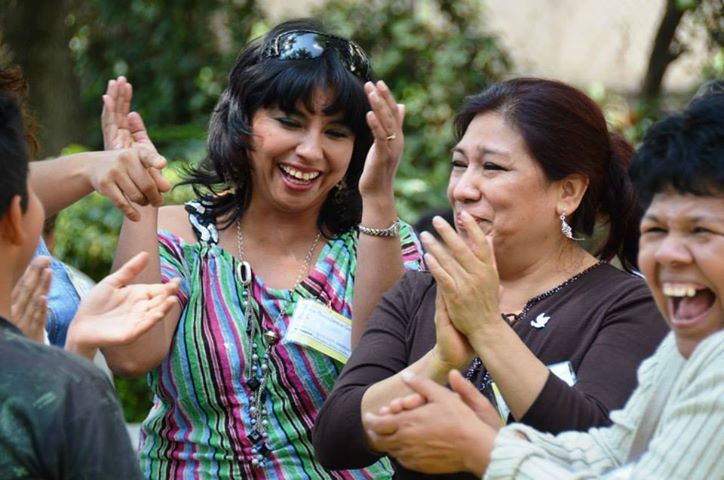
The Missio dei. In Latin, it means, simply, ‘mission of God.’ The term itself is perhaps symbolic of the way we have grown in our understanding of the relationship between mission, God, and God’s church. As a concept, missio dei has gained popularity and influence throughout the twentieth and twenty-first centuries. It emphasizes God’s role in mission, viewing God as the initiator of mission and the maker of history.
The idea of the missio dei puts theology at the center of the mission, or perhaps more accurately, mission at the center of theology. As missiologist Lesslie Newbigin put it, “[t]he Church is not so much the agent of the mission as the locus of the mission,” reflecting the understanding that the missional church is a witness to the working out of God’s divine purpose throughout history. [1] Through this lens, we see the mission of the church as sharing and reflecting the true meaning of the human story, which was revealed in the events of the Gospel. Our mission, then, is the continued interpretation of both cosmic history and our personal stories through the truth given to us in Christ.
I find it ironic and unfortunate that, despite the clear universality of God’s purposes in the missio dei, the Latin roots and origins of term itself still reflect a linguistically Euro- and Anglo-centric understanding of the church.
___________________________________________
Engaging the Christian movement in Africa, Asia, and Latin America is not optional in the construction of our twenty-first century missiology; it is essential.
___________________________________________
This is just one example of the oft-unspoken privileging of Western culture that is still widely prevalent in the church today. The overwhelming dominance of Western thought, education, theology, and ecclesiology has been referred to as the ‘Western captivity’ – or even the ‘white captivity’ of the church. [2] We can see this most clearly in the lingering legacy of the missionary movement throughout the global church. In the eighteenth, nineteenth, and early twentieth centuries, Western missionaries traveled around the globe, bringing not only the Gospel but also their Western cultural values and systems of thought. In the context of colonialism, these Western values were not necessarily benign but were rather the inroads of imperialistic nations who would go on to colonize many nations in the ‘mission field’ and seize their natural resources.

Even today, North American-style Christianity infiltrates and even supersedes native expressions of the faith in many cultural contexts where Christianity has taken root, replicating the theology and ecclesiological forms of the West rather than reflecting the context of the believers. Many churches in the Global South and the non-Western world have in recent years begun to deliberately reclaim and re-integrate their own cultural heritages within their expressions of Christian faith.
Even in Western nations, non-white Christians often remain ‘captive’ to the white, Western church. In the U.S., for example, the dominant narrative proclaims that Christianity is on the decline, a perception based on the real phenomenon of an ever-decreasing number of white church members. What the dominant narrative forgets to include, however, is that ethnic and immigrant churches in the U.S. are booming numerically, and that an increasing number of vibrant faith communities are being formed by non-white Christians. Author and professor Soong-chan Rah points out that, “[w]hat we are witnessing in the twenty-first century is the captivity of the church to the dominant Western culture and white leadership, which is in stark contrast to the demographic reality of Christianity in the twenty-first century.” [3]
___________________________________________
Today, if we were to look for a statistically representative face of Christianity, the face we would find would not be Western or white; it would belong to an African or Latin American woman.
___________________________________________
Today, if we were to look for a statistically representative face of Christianity, the face we would find would not be Western or white; it would belong to an African or Latin American woman. [4] In the last fifty years, Christianity has undergone a dramatic demographic shift towards the southern hemisphere and the ‘Global East’. It would be natural to ask how these new epicenters of believers have influenced thinking about mission and theology. However, from a ‘mainline’ (note the word!) perspective, hearing and engaging the voices and expertise of those outside of Western cultural hegemony remains the exception to the rule. The voices and theological insights that emerge from what is now the majority face of Christianity are subject to an upsetting marginalization and tokenism. They are relegated to ‘special topics’ and ‘contextual theology’ – as if we have somehow forgotten that all theology is contextual; that white, Western theology is no less influenced by the circumstances from which it emerged than any other theological orientation.

Photo: Lilia Maria Ramirez-Jimenez
However, when we recognize that the heartland of the faith and the national identity of the average believer fall outside of the West – specifically outside of North American or European identity – we must start asking how the missio dei might be conceived of differently, apart from the reification of European culture and values. If we truly believe that we are empowered by God’s mission, then we must understand that the same is true for the entire global church. [5] Engaging the Christian movement in Africa, Asia, and Latin America is not optional in the construction of our twenty-first century missiology; it is essential. The more Western churches open the canon of our own great traditions to include voices from across the globe in our theology, missiology, and ecclesiology, the more fully we participate in missio dei, the more fully we are integrated into the universal church.
This reality creates several unique challenges and opportunities for those of us who call the Western church home. Recognizing the Western cultural captivity of the church and equipped with the twentieth and twenty-first century critiques of colonialism, imperialism, and patriarchy, we can hear God’s call to re-conceptualize our thinking about missions in order to reflect a global, multiethnic missio dei.
___________________________________________
What might it look like to re-imagine a church history syllabus in order to reflect a non-Eurocentric understanding of the history of Christianity?
___________________________________________
First, we might start by rethinking what has traditionally been thought of as the ‘mission field.’ Those of us in the PC(USA) do well to remind ourselves that some places in the so-called mission field now have more people in Presbyterian congregations than we do in the United States. [6] Rather than thinking of the non-Western world as the mission field, perhaps we can begin to think of Africa, Asia, and Latin America as classrooms. We can look at the many expressions of the now-majority church as places where we in the West should go to listen and learn from the rich history and vibrant theology of these churches and believers.

Second, it is impossible to ignore one particular Western cultural artifact to which the church remains captive: racism. The reality of our world and our churches today is shaped by the legacy of colonialism and the strong inequity of resources between the West and the rest of the world – and between white and non-white populations in the West itself! We cannot ignore the fact that Western culture, structures, and institutions have often gone hand-in-hand with racial alienation and white supremacy. We must examine the unequal and unhealthy power dynamics that are too often present in mission work where white, Western Christians visit ‘third-world’ countries to do service for and to people in need, rather than participating in God’s mission with and alongside communities of faith that are already engaged in that holy work.
Finally, we can’t re-conceptualize our idea of mission without considering the theological education that drives it. What might it look like to re-imagine a church history syllabus in order to reflect a non-Eurocentric understanding of the history of Christianity? Despite the fact that native Christians in places like Japan and sub-Suharan Africa have been doing theology for centuries, the traditional European and North American curriculum still controls the education of seminary students both in the West and in the Majority Church. If we are honest with ourselves, our syllabi often reflect “clan history” rather than “church history” when we bypass telling the story of the whole people of God to focus on the early Roman church and developments in Western theology. Entire subjects such as ‘African Church History’ or ‘Asian Theology’ become special topics or electives – appendages to the dominant Western narrative of the church. [7]
___________________________________________
The missio dei would ask us to end this ‘Western captivity’ and give voice to the rich knowledge and traditions found in places the Western church once called the mission field.
___________________________________________
We fall short in our participation in God’s mission when we fail to acknowledge that any hierarchy which privileges Western thought, education, theology, and ecclesiology doesn’t adequately represent God’s cosmic vision. The missio dei would ask us to end this ‘Western captivity’ and give voice to the rich knowledge and traditions found in places the Western church once called the mission field. Living into God’s mission today requires us to critique and transform traditional attitudes and practices and to embrace more liberatory models for service. We must expand our definition of mission beyond preaching or teaching to include learning, listening, and being changed by the Spirit. [8] We must begin to see that the missio dei is also la misión de Dios (Spanish) or hananim-ui seongyo (Korean) or misyon ng Diyos (Tagalog).
 Our understanding of mission must reflect the new global reality of our faith in order to accurately represent the truth and scope of the human story and God’s cosmic vision for the world
Our understanding of mission must reflect the new global reality of our faith in order to accurately represent the truth and scope of the human story and God’s cosmic vision for the world
The church is missional for no less a reason that God, in every person of the Trinity, is a missional God. God asks us to look critically and reflectively at events of the past in order to rethink and reclaim God’s mission for the present and future. Whether it’s the missio dei or la misión de Dios, the mission of God propels us towards a hopeful vision of our cosmic future in Christ, a future that is at all times centered around God, the active agent by whom we are sent and to whom we respond with love and faithfulness, in the best way we can.
______________________________________________
[1] Lesslie Newbigin, The Gospel in a Pluralist Society. (Grand Rapids, MI: William B. Erdmans Publishing Company, 1989), 119.
[2] Soong-Chan Rah, The Next Evangelicalism: Freeing the Church from Western Cultural Captivity, (Downer’s Grove, IL: Intervarsity Press, 2009), 16.
[3] Ibid.
[4] Mark Noll, The New Shape of World Christianity: How American Experience Reflects Global Faith (Downer’s Grove, IL: Intervarsity Press, 2009), 19.
[5] Wilbert Shenk, “Recasting Theology of Mission: Impulses from the Non-Western World,” International Bulletin of Missionary Research 25, no.3 (2001): 98.
[6] Noll, The New Shape, 20.
[7] Andrew F. Walls, “Eusebius Tries Again: Reconceiving the Study of Christian History,” International Bulletin of Missionary Research 24, no.3 (2000): 106.
[8] Lesslie Newbigin, The Gospel in a Pluralist Society. (Grand Rapids, MI: William B. Erdmans Publishing Company, 1989), 124.
AUTHOR BIO: Alexis Presseau Maloof holds a Bachelor’s in Religious Studies and a Master’s in Writing, both from DePaul University in Chicago. She is a lifelong Presbyterian and an ordained ruling elder in the PC(USA). Formerly a writing instructor and manager of a literacies center at a community college, she is currently an at-home parent of one wild and wonderful little boy and enjoys freelance writing and blogging on her website in her spare time.
Read more articles in this issue: What Mission is This Anyway?





Unbound Social